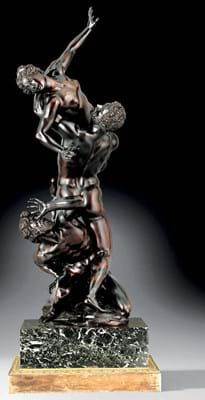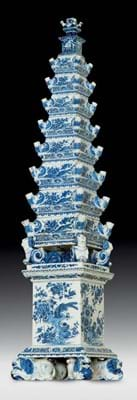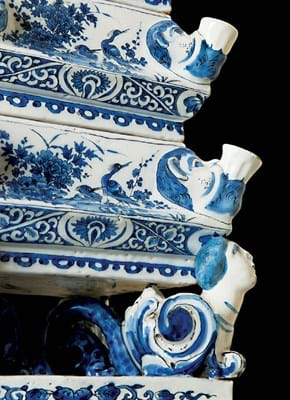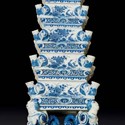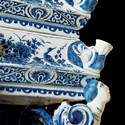A ‘rediscovered’ lifetime cast of Giambologna’s Rape of a Sabine topped Sotheby’s (25/20/13.9% buyer’s premium) sell-out auction of works from the collection of the Count and Countess of Ribes in Paris on December 11.
The Ribes Sabine, with a French royal provenance, was acquired for the Palace of Versailles collection at a hammer price of €3.8m (£3.23m).
The 2ft (60cm) bronze is considered one of the prime casts of this seminal Florentine late Renaissance model.
It joins a corpus of perhaps four other extant bronzes thought to have been made during Giambologna’s (1529-1608) lifetime by his talented studio assistant Antonio Susini (1558-1624).
These early casts, dating from c.1583 (the unveiling date of the finished marble at the Loggia dei Lanzi) until c.1610, share a number of common characteristics: incised pupils and irises to the eyes of each figure; the figure of the cowering Roman with a full beard that covers his chin; the Sabine woman wearing a diadem.
Royal ownership
The Ribes Sabine has been documented from 1689 in the French royal collection. It was one of two bronzes of the Rape of a Sabine in the collection of the Grand Dauphin, son of Louis XIV.
The engraved collection number 335 was added to the cast between 1711-13 and in c.1785 the famous French bronzier, Pierre Gouthière (1732-1813), was employed to restore it and to provide the then fashionable ‘smoke-colour’ patina ‘en couleur de fumée’.
It may have also been at this time that fig leaves were attached to the male protagonists (they had been recently removed) and the bronze was given its associated green marble and gilt-bronze socle.
After the Revolution, in 1796 the bronze was given as payment in kind to the state creditor Gabriel-Aimé Jourdan, then passed to his godson and adoptive son, Aimé-Gabriel d’Artigues (1773-1848).
His only daughter, Anne-Gabrielle d’Artigues (1833-1909), married Charles-Edouard, 3rd Comte de Ribes (1824-96), and by 1865 the bronze took its place in the family’s newly built hôtel particulier on Rue de la Bienfaisance. When it was last exhibited in 1956 its significance was not fully recognised.
The Palace of Versailles used its right of pre-emption to acquire the bronze on December 11, although not before bidding had reached an artist’s record. The price including buyer’s premium was €4.49m (£3.8m).
The previous high for the model was the premium-inclusive £3.67m bid at Christie’s Exceptional sale in London in 2014 for a version that is signed Gio Bologne. That one has been dated to c.1587-98 and is considered the earliest of the five known ‘prime’ Sabine casts.
The Ribes collection, began in the middle of the 19th century, was sold by the fashion designer Jacqueline de Ribes (née Jacqueline de la Bonninière de Beaumont), widow of the late Edouard de Ribes (1923-2013). The Sotheby’s offering of 59 works of art and 197 books totalled a premium-inclusive €22.8m.
Delft record
The stand-out results included an auction record for Delft pottery, courtesy of a pair of blue and white earthenware flower pyramids or obelisks c.1695-1700.
At 5ft (1.53m) high and in nine sections with spouts designed as chimera-like heads, these rank among the largest-known examples. Although often referred to as ‘tulip’ vases, they were made for displaying the blooms of a profusion of different floral species.
The six vases at Hampton Court were made for William and Mary by the A Grec (De Grieksche A) factory under the direction of Adriaen Kocks (1687-1701) – a probable candidate for the maker of this pair that share a number of similarities.
It is possible that, like other extant versions, they were originally surmounted by a bust of Queen Mary although sometime in the 18th century the top tiers were replaced in porcelain by a Chinese potter making a good stab at imitating Dutch chinoiserie.
The pair were probably owned by Edmé Antoine, 1st Comte du Puget (1742-1801), and came by descent to the Ribes family in the early 20th century. Estimated at €150,000- 250,000, they attracted plenty of interest before selling for €850,000 (£722,500).
Extraordinary snuff box
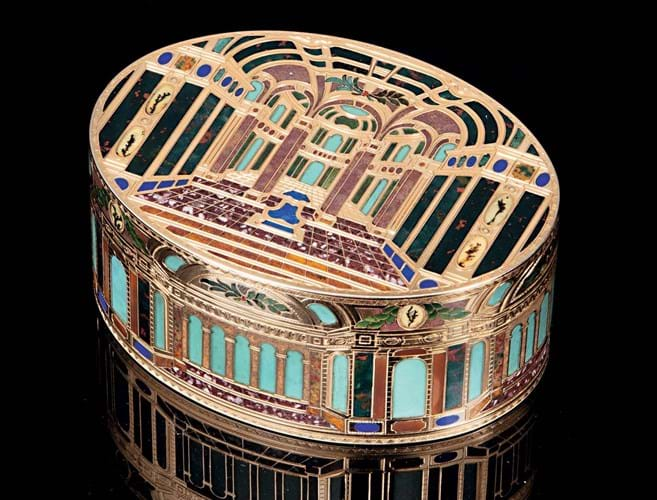
An 18th century gold and hardstone inlaid snuff box ascribed to Johann Christian Neuber, €1.5m (£1.27m) at Sotheby’s Paris.
A new high of €1.5m/£1.27m (estimate €500,000-700,000) was set for an extraordinary 18th century snuff box ascribed to the celebrated Dresden court jeweller Johann Christian Neuber (1736-1808).
Typically worked with a variety of hardstones within gold cagework, this (unsigned) box c.1770 is unusual on two counts.
Instead of the local Saxon geological specimens which Neuber successfully promoted in many of his boxes, it uses lapis lazuli from Afghanistan, porphyry from Egypt, Russian moss agate and the recently discovered chrysoprase from Poland.
The architectural theme of the decoration is also seemingly unique, positioning it close to a box in the Louvre inlaid with a perspective view of a garden terrace leading to a small pavilion.
The Ribes box had previously belonged to the banker Alexander Baring, 4th Baron Ashburton (1835- 89) whose collection was sold by his daughter Lilian (1874-1962) at Christie’s in 1947.
£1 = €1.18


